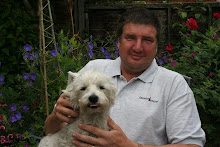When we lived in the UK we took part every year in the British RSPB "Big Garden Bird-Watch" which is a survey of garden birds by members of the public which takes place on a single weekend in January. Tens of thousands of people take part, spending an hour on one of the days bird watching in their garden and then recording what is the highest number of any species seen at any one time during the hour. They either post off their results recorded on a form, or can go on line and enter their data into the web survey. It has been running for many years now and is starting to show some interesting trends up or down in bird populations.
We had a good wildlife garden and used to feed the birds a variety of food all through the year so our scores were generally in ones and twos of all the 'usual suspects' - blue and great tits, blackbirds, greenfinches, dunnocks, a robin or wren if you were lucky and, very reliably, between 30 and 77 house sparrows of which we had a huge mob all the time in our holly bushes, beech hedge and trees and shrubs. If we were lucky our resident female sparrow hawk would nip through while we were on watch. Either way we had a pretty good idea of what our garden population was like.
When we moved here we were delighted by some of the differences in what we could describe as 'usual suspects'. The house sparrows are replaced here by a mob of around 17 chaffinches who gather up any poultry food left by the hens. We have never seen a house sparrow yet. Robins and wrens are ten a penny. Our 'crows' are the grey bodied Hooded Crow; UK-style black Carrion Crows being almost entirely absent from Ireland. We also do well for field fares and jackdaws. Coal tits seem to be more common than blue or great tits.
Also different is the 'peoples' survey'. Not for us the easy life of one hour on one day of a fixed weekend. The Irish version, run by Bird Watch Ireland involves keeping your eyes open for 13 weeks from early December through to the end of February and scoring the biggest number of each species you see at any point during that week. This is good for we out-door types, as I can 'watch' while I'm allotmenting or out round the ground with dogs. Liz and I have conversations where we are basically 'auctioning' the results in a series of bids. Liz saw 17 field fares today, for example, which meant I had to go into the website and up my previous record (4). It has a few minor frustrations mind - we wish we could have recorded the hen harrier who flaps lazily up the valley but never came into our 'airspace', or the kingfisher zipping up the River Lung from Feigh Bridge (again - not actually IN the garden). We get regular mobs of long-tailed tits through, too, but they have stayed away while I have been 'surveying'.
A quick warning for those readers who do not want to know about the 'meat-preparation' side of small holdings; Look Away Now (3 paragraphs). The 'Late' birds? That will be the young roosters hatched 17 weeks ago today by Broody Betty. It's been great to see it all happen and to nurture them up through babyhood and into adolescence but they turned out to be male and were starting to square up to each other, tried their hand at crowing and even tried to mount the hens. William the Conqueror was getting fed up with them and it was all getting a bit feisty. The hens would shrug them off but then turn round and attack them quite viciously. Someone was going to get badly hurt or even, if William got them cornered, killed. William is twice their size. I had offered them to anyone on the poultry forums but those guys are mainly breeders of pure fancy-fowl and a hybrid x hybrid of dubious parentage is of no use to them. The boys' times had come.
Dispatching them is my job, and Liz has volunteered for the role of plucker. I managed to grab one yesterday when it foolishly preceded me into the confined space of the goose house but the other one was having nothing to do with that. The advice in that case is to set the alarm for 'while it's still dark' and pay the hen house a visit while nobody can see to fly off and escape. Rooster 2 was therefore waiting his turn in the pluckery by the time Liz got up. Liz has tried 2 methods now and prefers the 2nd - the first was just to dry-pluck holding the bird half inside a dustbin liner - the 2nd involved dipping the bird in hot water for 5 seconds and then wet-plucking. The feathers come away easier but the wet feathers stick to your hands and to the bird so "at times it was a bit difficult to see where I'd been" said Liz.
Anyway, the two brothers are plucked, cleaned and in the freezer now, awaiting their turn to be made into coq-au-vin. Interestingly for 2 brothers, clutch mates and equal age young "roos", they were hugely different in carcass weights - one was 1193 g cleaned weight, the other 1833 g. They may, of course, have had different mothers - no end of hens were happily contributing to BB's clutch! Their livers, hearts and gizzards, sliced up and briefly fried off have featured in tonight's tapas style supper. Delicious.
And finally, we have found another secret egg stash left by Wandering Wendy when she doesn't feel like laying in the official nest boxes. We had seen her nipping into the goose house looking a bit guilty. The rabbit 'Maternity Unit' is in there, though currently empty and she had discovered that she could sneak in (yellow arrow) through a hole at the right hand end and nip along 5 feet or so, well out of sight (yellow cross). I only found these (7) eggs by squeezing my head round the gap and using a torch. I had to prise off one of the planks to extract the eggs. That was yesterday. Today I blocked up the hole and two (it turned out) hens were very loud in their complaints and hung around the hutches, even jumping up into them through the open doors and marching around inside as if looking for the nest site.
The picture here shows the hutches not yet complete, with no mesh. They now do have proper fronts with a hinged mesh panel. I decided that if I left the mesh door open and put some hay in the 'bedroom' they might use that. At least I'd know where the eggs would be instead of having to hunt under hedges, track WW across the fields or find an egg at random in the yard, outside the front door, on the drive or what ever. To my surprise two hens laid in the hutch (and nobody laid in the nest boxes) today. There is time, I think, for one final bit of egg-laying related tomfoolery. Yesterday Liz and I paused outside the back door to watch the hens pecking at some wheat I had thrown down in the yard, amused, as ever by their antics. Suddenly we both heard a "tick!" and, as the forest of legs parted we could see an egg on the ground right where they were pecking. As far as either of us could see no hen had actually stopped pecking at the seed, so they must be able to multi-task, pecking with one end while the other end pumps out an egg. They come out (we did not know) pointy-end first and we know this because the 'tick' noise we had heard was the shell getting broken slightly at that end where it hit the gravel and concrete of the yard. So now you know.
Monday, 18 February 2013
Of Birds; Listed, 'Late' and Laying
Subscribe to:
Post Comments (Atom)







No comments:
Post a Comment